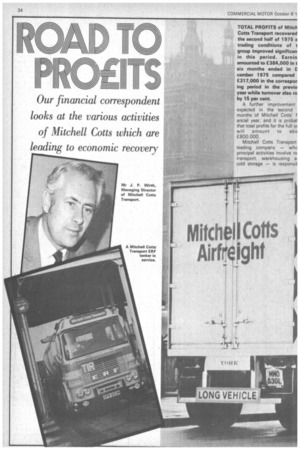ICDA
Page 36

Page 37

Page 38

If you've noticed an error in this article please click here to report it so we can fix it.
R07[=
Our financial correspondent looks at the various activities of Mitchell Cons which are leading to economic recovery
TOTAL PROFITS of Mitch Cotts Transport recovered the second half of 1975 a trading conditions of t group improved significan in this period. Earnin amounted to £384,000 in t six months ended in ID camber 1975 compared £317,000 in the correspor ing period in the previo year while turnover also ro by 15 per cent.
A further improvement expected in the second months of Mitchell Cotts' f ancial year, and it is probak that total profits for the full yE will amount to abo £800,000.
Mitchell Cotts Transport leading company — who principal activities involve ro transport, warehousing al cold storage — is responsit
Tlanaging a fleet of vehicles trailers. It owns a major ehousing complex at Penke, Staffordshire. It also has old storage site in Kent, ch extends to 16 acres. It is .ubsidiary of the Mitchell :s Group. which has a 77 cent interest in the corn-* y.
Aitchell Cotts Transport has a fast growth rate in recent rs, and its turnover has eased by an average of 22 cent over the past five rs. As shown in Table 1, lover reached £5,9m in the months ending in June 75 compared to £2.7m in
O-1.
)ver the 10-year span ween 1965 and 1975, lover has more than trebled I, the group has maintained above average rate of ansion throughout most of period (see graph 1).
The group has also been cessful in increasing its
earnings throughout the years, and the first setback it has suffered in its profits occurred during 1974-75. Total profits reached. a peak of £801,000 during 1973-74 but, as a result of the recession and co inflation, they dropped by 224 per cent to £622,000 in The following year (see Table 2).
It is believed that over 40 per cent of profits come from the warehousing activities, with road transport accounting for about one third of group profits.
Profit margins have varied from year to year but have averaged 16 per cent between .1971 and 1975. The trend in pre-tax profits as a percentage of sales is shown in graph 2, as well as trading margins in this period. These margins are satisfactory, and this shows the determination of management to maintain reasonable profitability despite the various problems which have been encountered.
The capital return has varied and has never been particularly high; over the past two years, it has averaged 12 per cent, which represented a small drop compared to the position in 1972-73, During 1974-75, Mitchell Cotts suffered from a variety of problems and like most major transport companies suffered from a fall in demand for its services as a result of the recession and the downturn in. the economy. Cost inflation also had a big impact on the group, even though the number employed by the group fell slightly in this period. For instance, the total payroll in 1974-75 rose by 20 per cent to reach £1.8m.
It is believed that the transport side, which is mainly involved in general haulage and contract hire, was particularly affected by these adverse factors, whereas the warehousing activities were reasonably satisfactory as a result of several rent reviews. Moreover, the cold storage facilities were expanded and a strong demand for this service was experienced.
During the first half of its current financial year, Mitchell Cotts managed to increase its profitability as, obviously, the recovery in the economy has played its part in helping the group.
Turnover was also rising in this period and the slower rate of cost inflation resulted in an improvement in margins for the company as a whole. It was encouraging that the interim dividend was increased significantly and amounted to 1.155 pence per share, a rise of 10 per cent compared to the previous year.
The outlook for the company is reasonably encouraging, and
the directors have said that -it is anticipated that profits will continue at this improved level during the second six months of the year.'" It is expected that in the January-June 1976 period, profits could amount to at least £400,000 and, on this basis, total earnings of about £800,000 could be achieved, which would be in line with the earnings recorded during the
peak year of 1973-74.
It is difficult to forecast th likely level of profits for the nex financial year but, assuminl that the economic recover' gathers pace, Mitchell Cott should be in a good position ti take advantage of the highe level of demand, which is for general haulage and ware housing over the next 1: months.




















































































